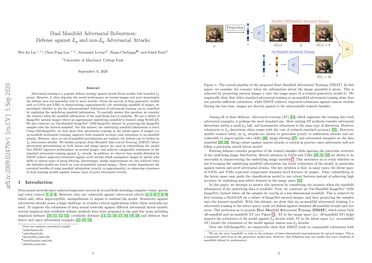Dual Manifold Adversarial Robustness: Defense against Lp and non-Lp Adversarial Attacks
Adversarial training is a popular defense strategy against attack threat models with bounded Lp norms. However, it often degrades the model performance on normal images and the defense does not generalize well to novel attacks. Given the success of deep generative models such as GANs and VAEs in characterizing the underlying manifold of images, we investigate whether or not the aforementioned problems can be remedied by exploiting the underlying manifold information. To this end, we construct an "On-Manifold ImageNet" (OM-ImageNet) dataset by projecting the ImageNet samples onto the manifold learned by StyleGSN. For this dataset, the underlying manifold information is exact. Using OM-ImageNet, we first show that adversarial training in the latent space of images improves both standard accuracy and robustness to on-manifold attacks. However, since no out-of-manifold perturbations are realized, the defense can be broken by Lp adversarial attacks. We further propose Dual Manifold Adversarial Training (DMAT) where adversarial perturbations in both latent and image spaces are used in robustifying the model. Our DMAT improves performance on normal images, and achieves comparable robustness to the standard adversarial training against Lp attacks. In addition, we observe that models defended by DMAT achieve improved robustness against novel attacks which manipulate images by global color shifts or various types of image filtering. Interestingly, similar improvements are also achieved when the defended models are tested on out-of-manifold natural images. These results demonstrate the potential benefits of using manifold information in enhancing robustness of deep learning models against various types of novel adversarial attacks.
PDF Abstract NeurIPS 2020 PDF NeurIPS 2020 Abstract

 MNIST
MNIST
 CelebA
CelebA